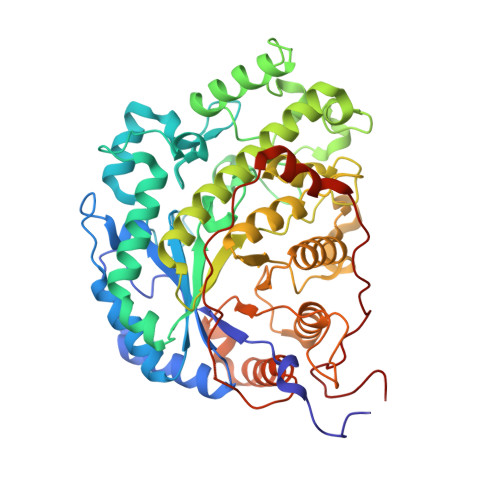Structural insights on starch hydrolysis by plant beta-amylase and its evolutionary relationship with bacterial enzymes
Vajravijayan, S., Pletnev, S., Mani, N., Pletneva, N., Nandhagopal, N., Gunasekaran, K.(2018) Int J Biol Macromol 113: 329-337
- PubMed: 29481953
- DOI: https://doi.org/10.1016/j.ijbiomac.2018.02.138
- Primary Citation of Related Structures:
5WQS, 5WQU - PubMed Abstract:
The conversion of starch to maltose is catalysed in plants by β-amylase. The enzymatic mechanism has been well-characterized for the soybean and barley enzymes, which utilise a glutamic acid-glutamate pair. In the present study, we present a surprise observation of maltotetraose at the active site, the presence of which elucidates the clear role of Thr344 as a conformational "switch" between substrate binding and product release during hydrolysis. This observation is confirmed by the selection of maltotetraose by the crystallized enzyme although that carbohydrate was present in only trace amounts. The conformation of the residues in the substrate-binding site changed upon substrate binding, leading to the movement of threonine, glutamic acid, and the loop conformation, elucidating a missing link in the existing mechanism. By aligning our substrate-free and maltotetraose-bound structures with other existing structures, the sequence of events from substrate binding to hydrolysis can be visualized. Apart from this, the evolutionary relationship among β-amylases of bacterial and amyloplastic origin could be established. The presence of a sugar-binding domain in the bacterial enzyme and its absence in the plant counterpart could be attributed to a carbohydrate-rich environment. Interestingly, cladogram analysis indicates the presence of N-terminal additions in some plant β-amylases. Based on sequence similarity, we postulate that the role of such additions is important for the regulation of enzymatic activity, particularly under stress conditions.
- Centre of Advanced Study in Crystallography and Biophysics, University of Madras, Guindy Campus, Chennai 600 025, India.
Organizational Affiliation:

















